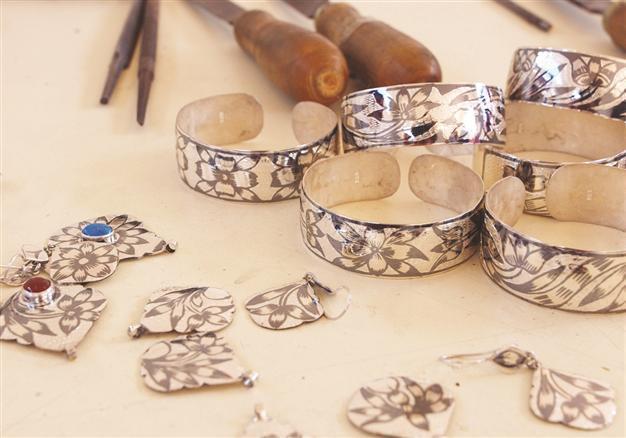Masters try to maintain dying art of savat silver
Wilco van Herpen ALPU, Eskişehir - Hürriyet Daily News

Photo by Wilco van Herpen
To tell you the truth, I like silver jewelry better than gold. When my father was incurably ill he gave me his favorite golden ring. The poor man lost a lot of weight in the course of his illness, and one day when he was working in the garden the ring slipped off his finger. With a swift move he was able to catch the ring before it fell into a muddy pond. Since my father gave this ring to me I wear it with pride, and it always gives me courage or strength during difficult situations.
In the central Anatolian province of Eskişehir I met a couple of silver craftsmen at their small workshop in Alpu, a small town 40 kilometers from Eskişehir itself. The village is a typical Turkish village with mainly “modern” (read concrete) houses. At first sight it did not impress me very much, but over the years I have learned that I should not draw conclusions too quickly: There is always an unexpected surprise waiting for you around the corner. It might take a while but I always find something that surprises me. This time the surprise was hidden away inside the buildings. But it wasn’t a beautiful old workshop or a fancy modern art gallery; no, it was an ordinary place in an ordinary street. From the outside the only outstanding about the place was the windows, which were in the shape of half circles, giving the master in the workshop plenty of light to work with.
Once I entered the workshop I entered a different world, the world of jewelry and of old and almost forgotten art. In the large room a couple of tables were filled with tools, silver wire, coin-shaped round pieces of silver and silver plates. Two men were sitting behind a table, with small sharp tools in their hands that they were using to draw motifs for
savat jewelry.
An old silver decoration techniqueSavat is a very old silver decoration technique that originates in
Dagestan. In the past there were many workshops producing savat work, but unfortunately this profession is slowly dying out. In places like Sivas, Erzincan, Trabzon and Samsung hundreds of Savat masters once decorated the best quality silver, but nowadays almost no masters remain. I was lucky to find one here in the village.
Savat means ”black” in Arabic. A savat master uses savat çamuru (“savat mud”), a mixture of lead, silver, copper and sulfur to create designs in the silver. Anything made of silver can be decorated in the beautiful savat style: a belt buckle, a cigarette box, earrings, bracelets, plates, you name it. Let’s say you want a beautiful bracelet: The master takes a piece of silver and starts tapping it until it is the right shape and thickness. Then he takes a special chisel begins drawing his motifs.
Each master used to have his own signature style, and people could recognize which master had done the savat decoration on a sword by the way it was designed. Slowly the motifs begin to become clear: flowers, curls, names or abstract patterns. When he finishes incising the decoration, the master polishes the bracelet, because the sharp edges of the cut motif might later cut the user. Now it is time to prepare the “mud.” The recipe of this mixture is very important; if he makes a mistake here the savat will not settle into the channels of the pattern well. He then rubs the mixture into the design, and burns the “mud” into the silver. Then the bracelet must be polished again, and the result is a beautiful “white” silver bracelet decorated with black motifs.
Since not many savat masters remain, the Alpu city council started a project to teach people this old technique. The idea is a good one, but unfortunately due to the high prices of silver the masters are not able to buy enough silver to make savat pieces and often out of necessity cannot make new models.
It surprises me in Turkey when I see beautiful traditional crafts like this one that unfortunately young artists or jewelry designers are not interested in learning those old skills and techniques. Recently some creative young people have begun to pick up the old Turkish crafts and make beautiful modern and old-fashioned pieces using velvet, glass, porcelain or other materials. It would really please me to see a group of young enthusiastic artists eager to learn the old art of savat silver and breathe new life into the craft of savat.
travel,
